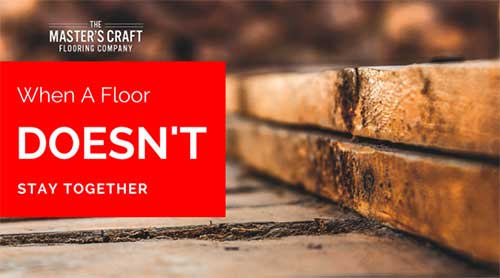I love it when a floor goes together.
Plank by plank, the steady beat of the mallet and boards snapping together and growing into a beautiful work of art.
Nothing is worse than getting a complaint sometime after the job is finished that gaps are starting to appear between the boards.
Today, we’re going to look at some of the reasons why abnormal gaps appear in wood floors.
First things first, be sure you have ruled out gaps resulting from a seasonal change, one of the most common and relatively normal types of gap. Get out the hygrometer and make sure your floor is being kept in an environment of 35-55% relative humidity.
Also, there are times when gaps are installed on purpose to allow for the wood to expand for an upcoming season. Typically, gaps are considered abnormal if they remain through a full seasonal cycle, or about 6 months.
The important things to consider in diagnosing why gaps happen are where the gap appears, what method was used to install the floor, and the flooring material itself.
Jobsite / Environment
This involves the location where abnormal gaps appear. Environment is critical to a happy floor, but also a well-prepared, well-acclimated jobsite can prevent gapping issues later on.
Proper acclimation
Solid hardwood flooring needs to acclimate to the normal living conditions of the home before it is installed.
Learn more about acclimation by watching our Acclimation 101 video here.
Materials or Jobsite
The wood flooring may have had a high moisture content at the time of installation and ended up drying out at a later point causing gaps. Also, materials with a low moisture content that are installed tightly will not have room for expansion if they acclimate to a higher moisture content. This particular issue leads to damage of the boards that can lead to gaps when the moisture content of the flooring returns to normal.
Foundation Issue
Cracks or uneven surface can transfer to the flooring. Floor boards will find a way to lay as flat as they can and if the subfloor isn’t flat, they may seat unevenly, causing gapping.
Hot Spots from Uninsulated Heating Ducts under Subfloor
You’ll see this in traditional subfloors where HVAC ducts are beneath the flooring. If not adequately insulated, the heat will transfer unevenly to the floor. Drying and shrinking may happen around spots with greater heat causing uneven shrinking and gapping.
Radiant Heat Systems
With the heating elements so close to the flooring, special consideration has to be made with the choice of flooring materials, correct installation of the heating system, and correct installation of the flooring materials. If not, radiant heat can quickly dry out your flooring, causing shrinkage and gaps to appear.
Something can be wrong with the installation.
Sometimes an abnormal gap doesn’t come from the wrong relative humidity or poor jobsite preparation. The issues begin with the installation.
Not Starting Straight
Taking the time to chalk a straight line and checking rows can make the difference in the finished product. When one board is off, whether that is the first row or a later row, subsequent boards will follow suit. The result is gapping.
Nailing Issue
Nails and fasteners can also play a role in the long term success of a floor. Make sure they set at the right depth and at the proper spacing according to the industry or manufacturer’s standards. Boards may be loose from not enough fasteners allowing for gaps. Or boards can be too tight not allowing for expansion leading to compounded issues from compression set.
Learn more about how to properly use your fastener in our article here.
Flooring Not Installed Tightly
Boards that are not pulled tight against neighboring boards will stay loose. That movement can shift throughout the floor and cause gaps.
Debris Between Boards
If the jobsite or subfloor wasn’t properly cleaned and vacuumed, debris may end up between boards not allowing them to be installed straight and tight.
Foot traffic before adhesive Dries
Check with the adhesive manufacturer, but if you step on a glued-down board too soon, you may slide that board right out of place. Weight on the floor from a stationary object is great to help the adhesive to cure, but the motion and weight of walking will quickly undo your hard work.
Something can be wrong with the material
It is not a common occurrence, but there are times where problems start at the mill with improper milling or tapered boards. A qualified inspector will need to be consulted to determine if this is an issue.
As always, if you have questions about pesky gaps that aren’t correcting after environmental considerations, let us know and we’ll be happy to help.


